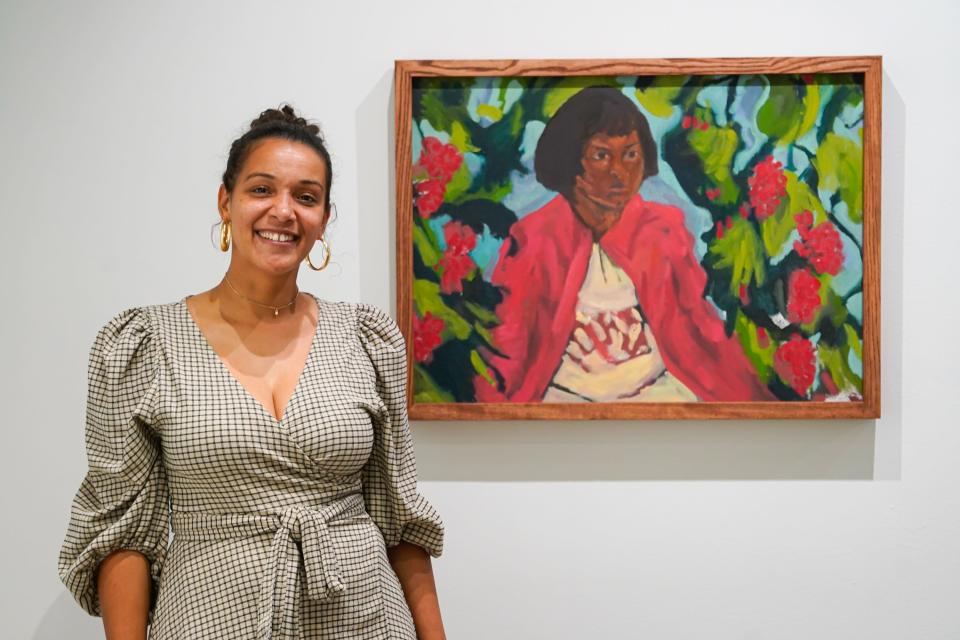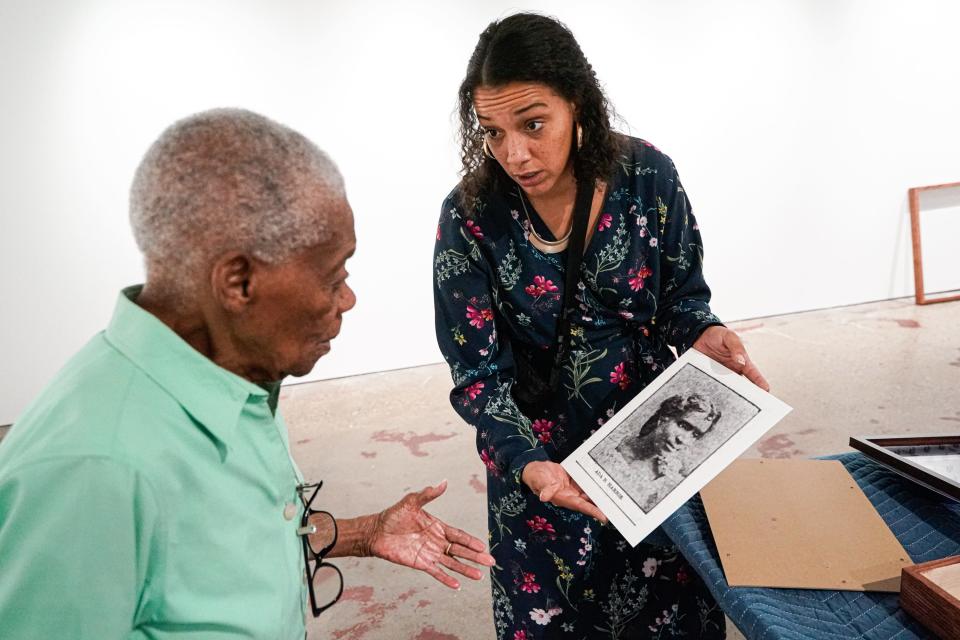An artist is re-imagining a famous Hoosier's lost Crispus Attucks mural in new exhibit
- Oops!Something went wrong.Please try again later.
In 1934, a famous Indianapolis artist painted a mural for Crispus Attucks High School. In it, muscled laborers, with sweat dripping, toiled in a fiery forge. The mural reflected the life of its painter, John Wesley Hardrick, who worked such jobs to provide for his wife and five children.
But schools officials didn't think the subject would inspire students to find white-collar jobs, and the piece was relegated to the basement and not displayed, one of his daughters told curators at the Indianapolis Museum of Art about 20 years ago. The mural — called "Workers" — has since been lost, a major missing piece by a Harlem Renaissance-era painter whose award-winning work hangs in museums and private collections. He died in 1968 at age 77.
Hardrick's mural has become a point of fascination once again as artist and historian Kaila Austin, Hardrick's family, and former neighbors have sought to honor his legacy. An exhibit that will open Friday at Big Car Collaborative's Tube Factory artspace will use multiple angles to explore the mural that has disappeared.
"Process as Practice: Reimagining the Lost Hardrick Mural" shows the artist's world — with master copies of work by his teachers and contemporaries. Photos of and art inspired by his southeast-side community of Norwood, which his family helped found as a freetown in the 19th century, will be central in the exhibit as well.
Using these pieces, along with Hardrick family stories, Austin will spend the next few months painting the re-imagined four-panel mural. Plans are for her to complete it by the end of November and for it to be on display for the December First Friday.
Hardrick's legacy and mystery: This famous Hoosier painted a mural for Crispus Attucks in the '30s. Why did it disappear?
"There's nothing like this," Big Car co-founder Shauta Marsh said. "She's collaborating with John Wesley Hardrick. She's collaborating with his descendants, and she's collaborating with the community that raised him and then bringing to light this whole history of our city" that hasn't been highlighted.
The freetown that informed Hardrick's work
The Hardrick family set up their residence in the area west of Vandeman Street and south of Prospect Street after the Ku Klux Klan forced them from their Kentucky home, according to family history. Once there, they helped build the freetown along with survivors of the 28th Regiment of U.S. Colored Troops in the Civil War.
Among the community's founders was Sydney Penick, the grandfather of current Norwood resident Flinora M. Frazier and the reverend who started the freetown's first church in 1889. His picture hangs on the wall of the Tube Factory exhibit, next to other members of Frazier's family. These are the fellow residents the Hardricks' ancestors would have known.
To longtime residents like Frazier, who is in her 90s, John Hardrick was more neighbor than famous artist.

"She didn't know that he was John Wesley Hardrick, the Harlem Renaissance painter. That was just her friend's dad," said Austin, who grew up in nearby Twin Aire.
Austin recorded the oral histories of Frazier and other neighbors who are settlement descendants for a 2021 Memory Keepers project, helping the freetown's little-known story to spread broadly. She learned about the city's former plans to build a morgue and forensics facilities on what was the Hardrick family's land, which neighbors fought last year. The city wound up canceling those plans and instead declaring it would help the neighborhood receive a state or federal historic designation.
How the site will be used specifically is yet to be announced. In the meantime, fueled by a 2022 Power Plant grant administered by Big Car and funded by the Andy Warhol Foundation for the Visual Arts, Austin is revisiting what's known about the missing mural and John Hardrick's influences.
What's known about the lost mural
On Dec. 18, 1933, John Hardrick lined up first at the John Herron Art Institute to apply to paint a federally-funded Public Works of Art Project.
The committee selected him, but after that details aren't clear. Hardrick's daughter Rowena Tucker later described what happened to the mural that depicted hard labor — a reality for many in the community at the time.
"The principal didn't approve of that kind of painting. He wanted doctors and lawyers and professions like that," she was quoted as saying in the catalog for "A Shared Heritage: Art by Four African Americans," a 1996 IMA exhibit. "So they (the murals) disappeared down into the basement and were never found."
School officials, Tucker said, didn't understand her father was actually promoting the importance of education.
Bookending her description are visual clues from the artist himself. Almost six years before, Hardrick had painted a mural of "Christ and the Samaritan Woman at the Well," which still hangs at Allen Chapel A.M.E. Church at 11th and Broadway streets. And his 1941 "National Malleable Company" shows laborers contending with a fiery forge.
But these artworks aren't the only clues she's using.
Learning the way Hardrick did
Austin has explored the works of those who influenced Hardrick's development — especially his teachers and contemporaries.
For example, she's painted master copies of pieces by T.C. Steele and Hale Woodruff. Hardrick once shared a studio with Woodruff, and he studied with members of the Hoosier Group, of which Steele was a member. And, of course, Austin copied Hardrick's own self portrait and famous work "Little Brown Girl."

Painting the works helped her to learn how the artists created tones and movement, to layer the colors like an Impressionist.
"It takes me from my hand to his," Austin said. "These are his teachers and he learns through their eyes. I can learn something about him through them, too."
The process differs from Austin's process of starting heavily before subtracting paint. Her own works are shown on a wall that includes her paintings of her daughter, friends and Norwood residents like neighborhood association president Brenda McAtee.
After the exhibit ends, the canvases of the re-imagined mural will be used as a mock-up for a piece that could go adorn a potential art center in Norwood.
If you go
What: "Process as Practice: Reimagining the Lost Hardrick Mural"
Where: Tube Factory artspace, 1125 Cruft St.
When: Opens Oct. 6 from 6 p.m. to 10 p.m. 9 a.m. to 6 p.m. Wednesday through Friday and 9 a.m. to 3 p.m. Saturday and Sunday. Through Dec. 17.
More info and related events: Follow Big Car Collaborative on Facebook and bigcar.org
Looking for things to do? Our newsletter has the best concerts, art, shows and more — and the stories behind them
Contact IndyStar reporter Domenica Bongiovanni at 317-444-7339 or d.bongiovanni@indystar.com. Follow her on Facebook, Instagram or Twitter: @domenicareports.
This article originally appeared on Indianapolis Star: Artist re-imagines famous Hoosier's lost Crispus Attucks mural

